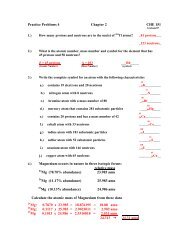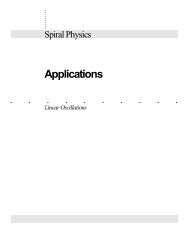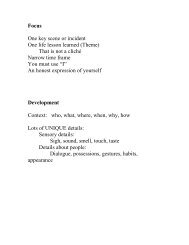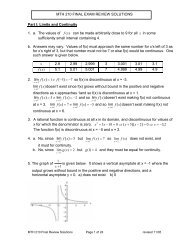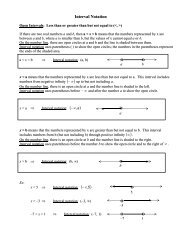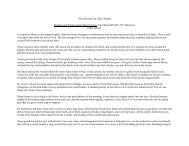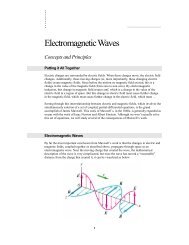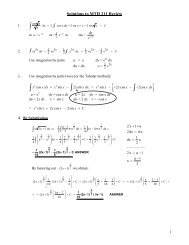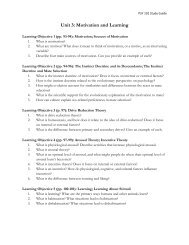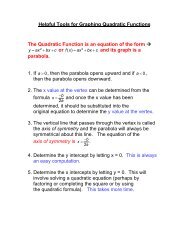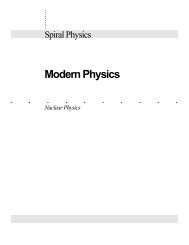Some Notes on Form and Function of the Line and Line Endings in ...
Some Notes on Form and Function of the Line and Line Endings in ...
Some Notes on Form and Function of the Line and Line Endings in ...
You also want an ePaper? Increase the reach of your titles
YUMPU automatically turns print PDFs into web optimized ePapers that Google loves.
itself. What’s more, <strong>the</strong> word “awkward” seems petty, selfish, neurotic—as if it were referr<strong>in</strong>g to<br />
an annoyance ra<strong>the</strong>r than a suicide. A careful reader might sense that this word is not <strong>the</strong><br />
pers<strong>on</strong>a’s but <strong>the</strong> mo<strong>the</strong>r’s. Maybe she has said this frequently s<strong>in</strong>ce his death. Whatever <strong>the</strong> case,<br />
<strong>the</strong> word reveals that <strong>the</strong> mo<strong>the</strong>r is not deal<strong>in</strong>g fully with <strong>the</strong> true impact <strong>of</strong> <strong>the</strong> fa<strong>the</strong>r’s death.<br />
The next l<strong>in</strong>e re<strong>in</strong>forces this noti<strong>on</strong>:<br />
<strong>and</strong> <strong>in</strong> a public park,<br />
Here we sense <strong>the</strong> mo<strong>the</strong>r’s shame <strong>in</strong> be<strong>in</strong>g associated with <strong>the</strong> fa<strong>the</strong>r’s public gesture <strong>of</strong> selfsurrender.<br />
Moreover, each l<strong>in</strong>e s<strong>in</strong>ce <strong>the</strong> beg<strong>in</strong>n<strong>in</strong>g has been add<strong>in</strong>g more c<strong>on</strong>text <strong>and</strong> <strong>on</strong>e more<br />
bit <strong>of</strong> <strong>in</strong>formati<strong>on</strong>. Now we not <strong>on</strong>ly get acti<strong>on</strong> but sett<strong>in</strong>g, too. The follow<strong>in</strong>g l<strong>in</strong>e reveals time:<br />
that spr<strong>in</strong>g<br />
This l<strong>in</strong>e emphasizes a fundamental ir<strong>on</strong>y: why would some<strong>on</strong>e kill himself <strong>in</strong> <strong>the</strong> spr<strong>in</strong>g, a time<br />
<strong>of</strong>ten associated with growth <strong>and</strong> rebirth? This ir<strong>on</strong>y is fur<strong>the</strong>r emphasized <strong>in</strong> <strong>the</strong> follow<strong>in</strong>g l<strong>in</strong>e:<br />
when I was wait<strong>in</strong>g to be born.<br />
The pers<strong>on</strong>a’s entrance <strong>in</strong>to life is juxtaposed with his fa<strong>the</strong>r’s exit from it. This life-death <strong>the</strong>me<br />
is enhanced when we realize all <strong>of</strong> <strong>the</strong> challenges that must face a s<strong>in</strong>gle mo<strong>the</strong>r under such<br />
circumstances. Although we never learn why this man has killed himself, enough detail <strong>and</strong><br />
acti<strong>on</strong> has been supplied to provide a dynamic <strong>in</strong>ternal <strong>and</strong> external c<strong>on</strong>flict for both <strong>the</strong> pers<strong>on</strong>a<br />
<strong>and</strong> his mo<strong>the</strong>r. The use <strong>of</strong> l<strong>in</strong>e breaks up to this po<strong>in</strong>t helps clarify this tensi<strong>on</strong>.<br />
While <strong>the</strong> first six l<strong>in</strong>es <strong>of</strong> “The Portrait” provide narrative details for <strong>on</strong>e event, <strong>the</strong> rest <strong>of</strong> <strong>the</strong><br />
poem focuses <strong>on</strong> <strong>the</strong> cause-effect relati<strong>on</strong>ship <strong>of</strong> <strong>the</strong> suicide. The poem now shifts to a different<br />
time: <strong>the</strong> life <strong>of</strong> <strong>the</strong> mo<strong>the</strong>r <strong>and</strong> child s<strong>in</strong>ce <strong>the</strong> suicide. Presumably years have passed, but, as <strong>the</strong><br />
follow<strong>in</strong>g metaphor reveals, her anger <strong>and</strong> hurt have not:<br />
She locked his name<br />
<strong>in</strong> her deepest cab<strong>in</strong>et<br />
<strong>and</strong> would not let him out,<br />
though I could hear him thump<strong>in</strong>g.<br />
The first l<strong>in</strong>e <strong>in</strong> this secti<strong>on</strong> emphasizes <strong>the</strong> act <strong>of</strong> lock<strong>in</strong>g a name, while <strong>the</strong> ensu<strong>in</strong>g l<strong>in</strong>e reveals<br />
where it is locked. The third l<strong>in</strong>e highlights <strong>the</strong> mo<strong>the</strong>r’s resolve <strong>in</strong> do<strong>in</strong>g this, though <strong>the</strong> f<strong>in</strong>al<br />
l<strong>in</strong>e—<strong>in</strong> an expert stroke <strong>of</strong> anti<strong>the</strong>sis—dem<strong>on</strong>strates that such repressi<strong>on</strong> cannot be successfully<br />
14



